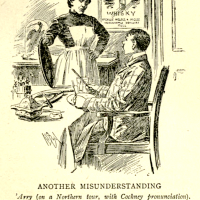I have spoken often enough of literary Providence: from time to time, the book we really need falls from the shelf, lands in our mailbox, or gets handed to us by a friend (or enemy) just when we need it. In scholarship, for me, that has meant finding out-of-print materials in used bookstores, being gifted poor-condition-but-still-costly 1st editions, and being part of a great social media community of scholars who often do the impossible. In archival research, there is also a kind of serendipity at play. In my own life, it was the discovery and publication of an unpublished preface of The Screwtape Letters that opened up new possibilities for reading Lewis’ work. Time and again, the magic of archives leads people to reveal the lost-but-found works of C.S. Lewis.
A few years ago, serendipity struck again with what is a rare find: a previously unknown essay by C.S. Lewis. While preparing to do research for her PhD at the University of Stirling on Lewis’ international reception, Stepanie Derrick discovered two entries in The Strand index referring to essays by Lewis that are not in any of our collections. Although published just after WWII, these articles have been overlooked ever since. You can read about her discovery in a recent Christianity Today article, “Christmas and Cricket: Rediscovering Two Lost C. S. Lewis Articles After 70 Years.”
Like most 20th-century British writers, Lewis had a bit of history with The Strand Magazine.
The Strand was where most readers first encountered Sherlock Holmes and some of Arthur Conan Doyle’s other stories. It became a massively popular magazine. Indeed, in a Nov 22nd, 1908 letter, one week before his eleventh birthday, Lewis wrote to his father in anticipation of reading the Strand for a schoolboy book club. A quarter of a century later, on Sep 6th, 1933, Lewis and his brother went for a swim and then a walk through Oxford. They landed at the Eastgate Hotel, where they languished at tea, reading old volumes of the Strand. Lewis later fictionalizes the moment in the hapless character of Mark Studdock, using his connection to Strand Magazine to describe Mark’s long journey out of and back into the self:
Mark went into the little hotel and found a kind elderly landlady. He had a hot bath and a capital breakfast, and then went to sleep in a chair before a roaring fire. He did not wake till about four. He reckoned he was only a few miles from St. Anne’s, and decided to have tea before he set out. He had tea. At the landlady’s suggestion he had a boiled egg with his tea. Two shelves in the little sitting-room were filled with bound volumes of The Strand. In one of these he found a serial children’s story which he had begun to read as a child, but abandoned because his tenth birthday came when he was half way through it and he was ashamed to read it after that. Now, he chased it from volume to volume till he had finished it. It was good. The grown-up stories to which, after his tenth birthday, he had turned instead of it, now seemed to him, except for Sherlock Holmes, to be rubbish. “I suppose I must get on soon,” he said to himself (That Hideous Strength 17.I).

The Strand was no doubt nostalgic for Lewis, but “nostalgia” is really just a word to evoke some effect of the past that we cannot describe. The Strand was specifically symbolic of something lost and recovered in his own childlike maturity. Perhaps this is why, just after publishing That Hideous Strength, Lewis agreed to write an article or two for the Strand. Indeed, there are echoes in the “Sermon” of That Hideous Strength and at least one direct quotation (from ch. 8, section III).
One of these newly discovered articles–an unusual piece written by “Clive Hamilton,” Lewis’ pen name in his 20s–is, for me, a doubtful connection. I’ll leave that to Dr. Derrick and others to discuss. But the Christmas piece of 1946 is most definitely a Lewisian discovery–not least for the upsidedown nature of the essay.
Knowing that he is supposed to be simply writing a Christmas sermon for post-Christians–pagan England after the collapse of Christianity–Lewis takes time to set the words “pagan” and “heathen” in context. Though beginning as words for backward countryfolk, people on the heath and in the pagus (village), in popular speech, “pagan” became a term for “pre-Christian.” To assume that post-Christian England will be like pre-Christian England, Lewis argues, is to assume that the experience of a widow is like that of a young woman before her wedding day, or that an uncultivated field and a ruined street are the same things.

Lewis then takes time to think about the difference between what a pre-Christian pagan was and what a post-Christian Brit might be like. The difference isn’t just disenchantment, the Western experience of losing that sense of the universe being alive. Real pagans, Lewis argues, had a clear morality of right and wrong, a true sense that what we do matters, and a fully integrated life in the natural world. By contrast, in the contemporary world, whether or not we are post-religious, nature is not a spiritual reality, the universe is a machine ready to hand for exploitation, and there is no ultimate right and wrong–only ideology. When something is wrong, Lewis suggests, the post-Christian Englishperson points to the Government or the education system or to God or whatever as the problem. Rarely does a post-Christian carry around a sense that they might be at fault.
Besides the dreary worldview of the post-Christian mechanistic universe–compared with the colour of the pagan world, at least–Lewis is concerned about the social and environmental implications of the approach current in his time. In particular, as he argues in The Abolition of Man (1943) and That Hideous Strength (1945), an imperial approach to nature is not merely “Man’s conquest of Nature” but “really Man’s conquest of Man.” Lewis was right that in WWII and the years after, the real question was how some people were going to rule others. Although the Soviet Union has collapsed–the so-called end of ideology–that temptation to oligarchical domination is in us, whether in public life, in cultural morality, or on social media.
In this “Christmas Sermon for Pagans,” as in The Abolition of Man, Lewis is really focused on warfare technology, environmental damage in the name of progress, and social control. Beyond the warning of those things, he suggests that we are going to need a root for our morality. In order to say that Nazi ideology is “wrong,” we need to compare it to something which is truly “right.” He leaves that root of truth against great evil open for the post-Christian world to discover.
Well, not totally open. In his characteristic way, Lewis turns everything on its head. Derrick includes this intriguing moment in her CT article:
“It looks to me, neighbours, as though we shall have to set about becoming true Pagans if only as a preliminary to becoming Christians. … For (in a sense) all that Christianity adds to Paganism is the cure. It confirms the old belief that in this universe we are up against Living Power: that there is a real Right and that we have failed to obey it: that existence is beautiful and terrifying. It adds a wonder of which Paganism had not distinctly heard—that the Mighty One has come down to help us, to remove our guilt, to reconcile us.”
Thinking of post-Christians and those Christians who have no knowledge of the pagan world, I can’t think of anything more horrifying at Christmas than this sermon (except children’s Christmas concerts, which I think are universally horrifying, but I seem to be alone in this belief). In many ways, it isn’t a very Christmasy sermon. Fortunately, it isn’t anything like his Christmas curmudgeon essays I’ve talked about before.
In the CT article, Derrick describes her find in terms I can resonate with: “The thrill of discovery has brought home a few points (of encouragement) in a time when it sometimes seems as though all the stones have been overturned.” More than ever, I am convinced not all archival stones have been turned, that there are still discoveries to be had. More than the great moments–and this neat discovery is small compared with the work of Derrick’s research project as a whole–working in the archives brings a thousand additions, clarifications, and little points of interest to any curious reader. Archive research is like the sand settling between the stones in a jar, filling in the unknown empty spaces of our research for a fuller knowledge of what we study.
I would encourage you to read Stephanie Derrick’s CT article. Serendipitous discoveries can occur in twos. In volume 34 of SEVEN journal, Joel Heck (of “Chronologically Lewis) and Christopher Marsh provide a transcription and an introduction, “Discovering ‘A Christmas Sermon for Pagans.'” I hope you enjoy this unusual piece, and best wishes at Christmas!





Stephanie Derrick’s PhD research was published by Oxford University Press as The Fame of C. S. Lewis: A Controversialist’s Reception in Britain and America. Here are some other important books that assess C.S. Lewis’ impact:
- Samuel Joeckel, The C.S. Lewis Phenomenon: Christianity and the Public Sphere (2013)
- George Marsden, C.S. Lewis’s “Mere Christianity”: A Biography (2016)
- Alan Snyder, America Discovers C. S. Lewis: His Profound Impact (2016)
- Mark Noll, C.S. Lewis in America: Readings and Reception, 1935–1947 (2023)
- Chad Walsh, The Literary Legacy of C.S. Lewis (1979)
The cover of The Strand with C.S. Lewis and Laurence Olivier reminds me of one of my favourite Christmas movies, A Christmas Story (or the Ralphie movie, as we call it).


























Pingback: C. S. Lewis: “A Christmas Sermon for Pagans” – Breathe
Three points, Brenton, to add to your excellent and stimulating (as always) post.
First, the angle-and-devil cartoons in Lewis’s “The Strand” Christmas Sermon are by Ronald Searle. At the time he had recently returned to Britain after terrifying experiences as a Prisoner of War of the Imperial Japanese, during World War II, in Changi Prison and on the even more infamous Burma-Siam (Burma-Thai) Railway.
Searle had been a budding cartoonist just before the war broke out (3 September 1939). After the war, and after these pieces of “Strand” marginalia, his artistic breakout was with the delightful creation of the schoolgirls of (fictional) St Trinian’s girl’s school. (During his POW years he kept a secret sketchbook of POW life that was eventually published: a harrowing visual document.)
Ronald Searle developed a striking and unique visual style, and dark sense of humour. Several great films benefitted also from his spirited animated Titles.
Second, the beautiful cover illustration for that issue of “The Strand” is by Edward Ardizzone, a remarkable artist, author, and book illustrator (for children’s and adult books). He also had a unique visual style, and a deeply human warmth in his pictures, and books. He was also recently returned to civilian life after serving in Britain, France, and the Mediterranean as an Official War Artist.
Amongst a large body of work, Ardizzone also created an outstanding modern altar painting for a church in England.
https://www.stjudeshrine.org.uk/about/tour-parish-church
Third, one of the great Christmas films of Hollywood, “The Bishop’s Wife” (loosely based on a novella by Robert Nathan, author of “Portrait of Jennie”, also a major film), opens with children peering into a decorated toy-filled store window. (The film stars Cary Grant as an angel, David Niven as an Episcopal bishop in New York, and Loretta Young as the bishop’s wife.)
I strongly commend Ronald Searle, Edward Ardizzone, and “The Bishop’s Wife” to you, and your readers, with my best wishes for Christmas, and a marvellous new year!
Thanks for this on all points! Searle and Lewis seem also to have been contributing to Punch in the same after-war period – but I assume I’d have to find some library with the right paper archives to look into that further. I’d imagine the Lewises would enjoy Nigel Molesworth, whether in Punch from 1939-42, or later in the books Searle illustrated, but haven’t tried to do my homework about that in Lewis’s letters (and found nothing in Warren’s diary-excerpts index).
I suspect “children peering into a decorated toy-filled store window” may have been (and still be?) a topos or whatever – I’ve recently encountered it in Dutch newsreel footage of the 1930s, too!
With good wishes to you and all on this Feast of St. John or this Feast of the Holy Innocents, depending on one’s time zone, and for the rest of this Christmastide and the coming year!
Here’s one – with elaborate variations – from about :39 through 1:40, and related to St. Nicholas rather than Father Christmas:
Hi! Sorry of the delay, Elizabeth, I just haven’t been well. Thanks you for the great set of very cool resource connections.
Dorothy Parker and C.S. Lewis in the same magazine — we can see this is before the reign of computer-targeted marketing.
Yes, they weren’t poetic kindred spirits. And when I see Laurence Olivier, all I can think about is Roland Barthes talking of his shaved oily head.
Parker was in a writing group, and Lewis. I wonder how often the different big groups of the period were sitting together at tables like this.
Thank you for sharing this wonderful find, Brenton. I enjoyed your commentary more than Lewis’s essay itself, I’m afraid.
Lewis, as always, is prescient and brings up so many problems that have come to a crescendo, for better or for worse, with the Internet and overwhelming access to every opinion in the world. It is so easy to be disconnected from the natural world (not to mention the irony that commercialized Christmas is a nightmare of waste), so easy to be cynical or play ignorant, so simple to point the finger at others and never do any self-reflection. I think it’s heartening to see more and more people turn their backs on materialism, to gift each other experiences rather than things. These universal truths are why I love reading Lewis even though I’m not Christian nor was raised Christian.
I just don’t feel this essay was very well-argued. I think my frustration with Lewis’s writing is that his argument for why Christianity is “The Truth” is because, “It just is.” I don’t blame him—how can you prove the unprovable? That’s the whole point of faith—and I do think this argument in some ways explains his long-lasting appeal: he is speaking to an audience of lapsed Christians, not trying to convert people who do not have Christian backgrounds. But for those of us who were never forced to attend church, never had “Jesus is the Lord” drilled into our heads when we were too young to understand the lesson, the argument falls a little flat.
My Grandmother loved Christmas and planned for it all year. I think, as a child of the Depression, she loved presiding over a party where she could make sure everyone had mountains of presents. The presents were never important to me, unless they were books or art supplies. Christmas was about coming together as a family, good food and good cheer. And maybe my family should follow Lewis’s lead and call it Pagan Christmas: a time to come together to celebrate all that is universally good.
I hope you and all of your readers had a lovely Christmas, Christian or no. This year my family did the traditional Jewish Christmas of Chinese food and chatting, I’m hoping next year we’ll have the energy to do our “traditional” Pagan Christmas.
Hi CeCi, sorry I am so slow to respond to this smart note. I have been ill in much of the Fall and especially over Christmas, and struggling as a new term begins.
I see precisely what you are saying–though I did not have a “Jesus is Lord” upbringing, except through cultural osmosis. In a sense, I was that Pagan Post-Christian he was talking to, though I was really more a heathen. Or a Canadian, I guess.
I read your comments and think the title should be “In Praise of Paganism in a Post-Christian Cultural Slumber.”
I hope this is a grand Christmasy year!
super fun that stuff like this is still out there. frustrating as well. I learned recently that his mother wrote a short story that apparently has not survived. someone probably has it in their attic somewhere.
Yeah, I know, I wonder about those attics.
Pingback: Merry Old Christmastide Links | Brandywine Books
Alas, good old Christianity Today will not let me read Stephanie Derrick’s article online beyond the third sentence of the third paragraph: membership has its privileges, and only money seems permitted to talk in certain circumstances… Maybe I can find a library open to me which has a subscription – and a paper archive…
Perhaps, in these circumstances, you could provide the bibliographical details with respect to “Cricketer’s Progress” (which CT mentions between title and author) which is presumably the “unusual piece written by ‘Clive Hamilton'” – whoever of that name (or pseudonym) he (or she, or they) be… Maybe I can find the relevant issue of The Strand accessibly online if I know, e.g., the date, volume, number, pages…
In any case, many thanks for this definite Lewisian (re-)discovery and for considering it in context as you do!
There are so many fascinating comparisons to be made – within Lewis’s writings, and, I venture, where Tolkien is concerned, too. One of the former is Lewis’s ‘A Christian Reply to Professor Price’/’Religion without Dogma?’ – though I only know Walter Hooper’s edition with “all the marginal emendations which Lewis made in his copy” of the “Autumn 1946” version and “those portions from the Socratic version which he had omitted in his revision” of it. There, he writes “almost I’d sooner be a pagan suckled in a creed outworn. Almost, but not, of course, quite. If one is forced to such an alternative, it is perhaps better to starve in a wholly secularised and meaningless universe than to recall the obscenities and cruelties of paganism.” And, after two intervening sentences, “I shall not be expected at the end of this paper to begin an apologetic for the truth of Christianity.” This current ‘Sermon’ seems both gently but also sharply meant to nudge people – his English-speaking, Strand-enjoying “neighbours”- to do a bit of thinking (and reflecting). He could enumerate the horrors of the “post-Christian” (where, e.g., a decade earlier in the ‘Holdomor’ millions had been deliberately starved to death by the State), but instead, on the whole, quietly allows the readers to arrive at them on their own.
Hi David, sorry I am so slow to respond to this smart note. I have been ill in much of the Autumn and especially over Christmas, and struggling as a new term begins. I hope you are well.
It really is a “nudge,” not a sermon. I love your Pagan link there, because I’m sure that Lewis knew he was being culturally subversive in praising pagans.
Great essay, thanks for the reprise. And great catch on the Mark Studdock incident!
Hey, thanks! It all seemed to connect.